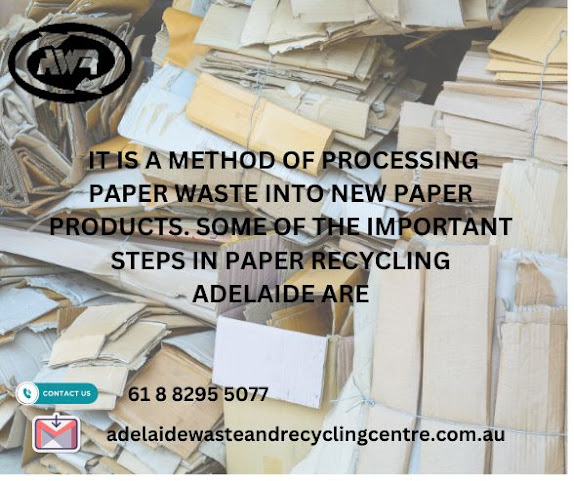Paper Recycling and Rubbish Removal Are Beneficial for Environmental Protection
Even though the world is aiming to go paperless, we really can't discard the essence of paper completely. With its diverse set of uses, it is clear that we are not getting away with paper anytime soon. Rather, if we observe, its use is only going to increase.
From school notebooks
to office files to packaging, paper is literally used everywhere. With the
growing population, paper use is going to increase, and as a result, the waste
generated from paper products will only rise. Today, most industries and
households are major sources of paper waste. We should be ready with our
approach to dealing with paper waste.
Perhaps the simplest
way to handle paper waste products is paper recycling. It is a method of
processing paper waste into new paper products. Some of the important steps in paper
recycling Adelaide are:
1.
Collection
The initial step
involves gathering paper waste from production sites, typically facilitated by
waste management companies engaged by industries and households.
2.
Sorting
In this step, the
paper waste is sorted and segregated according to its types, and it is stored
in separate containers. These containers are properly labeled for better
identification.
3.
Transportation
The containers
carrying the paper waste are placed in special trucks. These trucks are
specifically designed to carry such waste, and they help transport the paper
waste from the place of generation to the facility centers for recycling.
4.
Processing
This is the step
where the actual recycling procedure takes place. Here, the paper waste that
was collected is pulped, cleaned, and refined for making new paper products.
After the pulp is prepared, it is then processed into sheets and rolled into
recycled paper products like office pages, wrappers, and notebooks.
The sub-steps of
Processing are mentioned below.
A.
Pulping
Once the second round
of sorting inside the center is completed, the paper waste is mixed with water
to form a pulp. This is done to break contaminants like fibers and ink.
B.
Deinking
Even after pulping if
the paper has residual ink, then methods like flotation and washing are
undertaken to remove the ink.
C.
Screening
Any remaining
contaminants in the paper product are screened and cleared.
D.
Refining
Using several industrial
processes, refining is done to improve the quality of the paper product.
E.
Formation
Paper formation
begins in this technique and the pulp is diluted with water to form a slurry,
which is then spread to a wire mesh to create a continuous paper sheet.
Public awareness of
the benefits of recycling paper has increased significantly. Numerous paper
products can be manufactured using recycled paper, including notebooks,
printing paper, boxes, cartons, envelopes, letter pads, tissues, napkins, greeting
cards, newspapers, magazines, and paper bags. Specific guidelines for recycling
paper waste are followed in Australia.
If you are looking to recycle your paper waste in North Plympton, you can contact the executives of Adelaide Waste Recycling Centre. The experienced professionals of the company can tailor a recycling collection service to best fulfill your requirements by attending your premises to conduct an error-free analysis. This customization facility makes it unique among every waste management company in the country. It offers the best waste disposal services to Adelaide's businesses and residents, whether you are cleaning up the office or taking your recyclables in for environmentally friendly processing. Adelaide Waste Recycling Centre is also an expert in Adelaide rubbish removal. Some of the most common rubbish types accepted by it are:
·
Aluminum
cans
·
Batteries
·
Cardboard
and paper
·
Electronic
waste
·
Empty
gas bottles
·
Furniture
and household items
·
Glass
bottles and jars
·
Metals
(both ferrous and non-ferrous)
·
Mobile
phones
·
Electronic
Products
·
Oils,
including used mineral engine oil
·
Paint
(water or oil-based paint)
·
Textiles
and wearable clothing
·
White
goods and appliances




.jpg)
Comments
Post a Comment